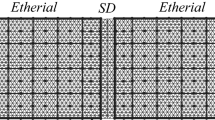Abstract
Multiscale discrete element model adapting information on material microstructure is introduced. Modeled structure is represented by a set of tetrahedral elements bound by their faces. Each element has an associated atomic sample, which represents atomic structure of the element. All element properties are determined from molecular dynamics simulation of its associated sample. Therefore, none of the specific properties of the material are needed aside from its atomic composition and microstructure. The chapter focuses on elastic behavior of modeled structures. Comparisons of the results obtained using multiscale discrete element simulation with molecular dynamics data and known macroscopic material properties show fairly good accuracy of the proposed model.
Access this chapter
Tax calculation will be finalised at checkout
Purchases are for personal use only
Similar content being viewed by others
References
Tadmor, E.B., Miller, R.E.: Modeling Materials. Continuum, Atomistic and Multiscale Techniques. Cambridge University Press, Cambridge (2014)
Abgaryan, К.К.: Multiscale Modeling in Material Science Problems. MAKS Press, Moscow (in Russian) (2017)
Shabana, A.A.: Computational Continuum Mechanics, 3rd edn. Wiley, Hoboken (2018)
Burago, N.G., Nikitin, I.S., Yakushev, V.L.: Hybrid numerical method with adaptive overlapping meshes for solving nonstationary problems in continuum mechanics. Comput. Math. Math. Phys. 56(6), 1065–1074 (2016)
Moës, N., Dolbow, J., Belytschko, T.: A finite element method for crack growth without remeshing. Int. J. Numer. Meth. Engng. 46, 131–150 (1999)
Youping, C., Lee, J.D., Eskandarian, A.: Meshless Methods in Solid Mechanics, 1st edn. Springer, New York (2009)
Vasilyev, A.N., Kolbin, I.S., Reviznikov, D.L.: Meshfree computational algorithms based on normalized radial basis functions. In: Cheng, L., Liu, Q., Ronzhin, A. (eds.) Advances in Neural Networks, pp. 583–591. Springer International Publishing (2016)
Stellingwerf, R.F., Wingate, C.A.: Impact modeling with smooth particle hydrodynamics. Int. J. Impact Eng. 14, 707–718 (1993)
Connolly, A., Iannucci, L., Hillier, R., Pope, D.: Second order Godunov SPH for high velocity impact dynamics. In: Papadrakakis, M., Kojic, M., Tuncer, I. (Eds.) Proceedings of the 3rd South-East European Conference Computational Mechanics, pp. 13–35 (2013)
Chen, Y., Zimmerman, J., Krivtsov, A., McDowell, D.L.: Assessment of atomistic coarse-graining methods. Int. J. Eng. Sci. 49, 1337–1349 (2011)
Abgaryan, K.K., Zhuravlev, A.A., Zagordan, N.L., Reviznikov, D.L.: Discrete-element simulation of a spherical projectile penetration into a massive obstacle. Comput. Res. Model. 7(1), 71–79 (2015)
Abgaryan, K.K., Eliseev, S.V., Zhuravlev, A.A., Reviznikov, D.L.: High-speed penetration. Discrete-element simulation and experiments. Comput. Res. Model. 9(6), 937–944 (2017)
Psakhie, S., Shilko, E., Smolin, A., Astafurov, S., Ovcharenko, V.: Development of a formalism of movable cellular automaton method for numerical modeling of fracture of heterogeneous elastic-plastic materials. Frattura ed Integrita Strutturale 24, 26–59 (2013)
Groot, R.D., Warren, P.B.: Dissipative particle dynamics: bridging the gap between atomistic and mesoscopic simulation. J. Chem. Phys. 107(11), 4423–4435 (1997)
Peters, B.: Measurements and application of a discrete particle model (DPM) to simulate combustion of a packed bed of individual fuel particles. Combust. Flame 131(1–2), 132–146 (2002)
Acknowledgements
The reported study was funded by RFBR, project number 18-08-00703.
Author information
Authors and Affiliations
Corresponding author
Editor information
Editors and Affiliations
Rights and permissions
Copyright information
© 2020 Springer Nature Singapore Pte Ltd.
About this paper
Cite this paper
Zhuravlev, A.A., Abgaryan, K.K., Reviznikov, D.L. (2020). Discrete Element Method Adopting Microstructure Information. In: Jain, L., Favorskaya, M., Nikitin, I., Reviznikov, D. (eds) Advances in Theory and Practice of Computational Mechanics. Smart Innovation, Systems and Technologies, vol 173. Springer, Singapore. https://doi.org/10.1007/978-981-15-2600-8_17
Download citation
DOI: https://doi.org/10.1007/978-981-15-2600-8_17
Published:
Publisher Name: Springer, Singapore
Print ISBN: 978-981-15-2599-5
Online ISBN: 978-981-15-2600-8
eBook Packages: Intelligent Technologies and RoboticsIntelligent Technologies and Robotics (R0)




